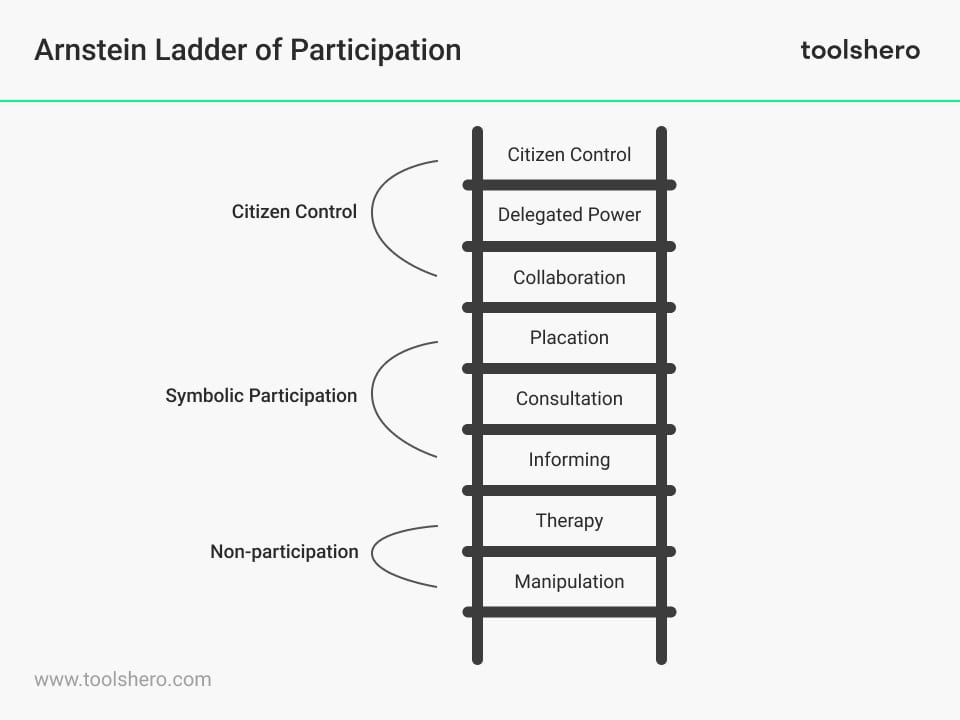Ladder of Participation (Arnstein)

Ladder of participation: this article explains the ladder of participation or ladder of citizen participation, developed by Sherry Arnstein in a practical way. The article starts with an introduction, followed by a general explanation of the ladder of participation, a practical example and tips on how this method can help you to participate more in society. Enjoy reading!
What is the ladder of participation?
Citizen participation is about changing the way politicians, developers and citizens interact and make important decisions. It is essential for a healthy democracy that they work well together, because people want to feel responsible and involved in their communities.
But what does good citizen participation actually look like? That’s where Arnstein’s Ladder of Citizen Participation comes in, also known as the ladder of participation.
Arnstein ladder of participation theory explained
Arnstein’s Ladder of Participation is a concept that helps us understand the different levels of citizen participation.
The lowest rungs represent the low levels of participation, such as simply informing or reassuring citizens. On the highest rungs we have real citizen power, such as partnerships or citizen control.
All rungs are briefly explained below.
- Manipulation: Citizens are manipulated and have no real influence on the decision-making process.
- Therapy: Citizens are involved in activities aimed at changing their attitudes or behavior, but still have no control over the decisions.
- Informing: Citizens are informed about plans and decisions but have no opportunity to voice their opinions or exert influence.
- Consultation: Citizens are consulted, and their input is gathered, but the final decision still rests with the authorities.
- Placation: Some points of feedback are incorporated, power remains with the authorities.
- Collaboration: Citizens collaborate with the authorities to make decisions. Power is shared, and there is shared ownership.
- Delegated Power: Citizens are given more power.
- Citizen Control: Citizens have full control over the decision-making process and its implementation. They have the ultimate say and bear the responsibility.

Figure 1 – Arnstein’s Ladder of Paticipation
Example of the ladder of participation
Imagine you are planning a surprise party. If you only inform your friends about the party, but don’t involve them in the planning process, that corresponds to the lowest rung on the ladder.
But if you actively involve them, ask for their opinion and give them a say in decision-making, it is comparable to the highest rung on the ladder.
Arnstein emphasizes the importance of increasing citizen participation to ensure everyone’s voice is heard and their needs are met.
The ultimate goal is to reach the top levels of the ladder, where citizen control is realized. It is important to note that not all situations require or allow such high levels of participation.
To ensure effective citizen participation, an engagement framework has been developed that includes a minimum standard of engagement.
This framework is based on experience with engagement projects and collaborations with government organizations. It includes:
Accessibility
Using a mix of channels tailored to the community, with clear objectives and content.
Transparency
Making information available, clearly indicating the sphere of influence and the process from the start, in understandable language.
Timing and process
Addressing community needs, the iterative process for better results and on-time delivery.
By following this framework, good citizen participation is strived for and it is ensured that planning decisions are inclusive and beneficial for all.
Origin of the Ladder of Participation
The ladder of citizen participation was proposed by Sherry Arnstein, in 1969.
She wanted to understand how citizens could have a say in decision-making processes and gain more power in democratic societies. Arnstein’s concept became very influential and well known in the field of public participation.
Her ladder model also inspired other similar models developed by different people. For example, Elizabeth Rocha developed the Ladder of Empowerment and Roger Hart invented the Ladder of Child Participation.
These models all share the idea that citizens should have a voice and be involved in decisions that affect their lives.
Arnstein’s main argument was that citizen participation is not just about having a say; it’s about real power. She believed that if citizens could not influence decisions or if their opinions are not taken seriously, their participation is not meaningful.
Rung 1: Manipulation
The first step of the ladder of participation is called “manipulation”. In simple terms, manipulation in this context means that the people in positions of power control the decision making and do not really give the citizens a chance to express their opinion. It is like someone who tries to mislead or influence others without regard to their opinions or needs.
Citizens may be provided with information in this step, but it is often biased or presented in a way that benefits those in power.
The decision-makers pretend to involve citizens, but their input is not taken seriously and the final decisions are made without their real involvement.
Rung 2 of the Ladder of Participation: Therapy
This step gives the impression that citizens are involved in the decision-making process, but their role is limited to expressing their concerns and frustrations.
Therapy means that those in positions of power listen to citizens and try to reassure them, but there is no real intention to take their input seriously or integrate their views into the decision-making.
It’s like offering emotional support without actual change.
Rung 3: Informing
The third rung of the ladder of citizen participation is called “informing”. In plain language, this means that those in positions of power provide information to the citizens.
They share important data, facts and plans with the citizens, but there is no real space for interaction or involvement.
Informing means that citizens are informed of decisions and developments, but it remains a one-way street.
The emphasis is on providing information, but there is little room for citizens to have their say or influence decision-making.
Rung 4: Consultation
The fourth rung of the ladder of citizen participation is called “consultation”. Citizens are actively invited to share their opinions and ideas about decisions and plans that may affect them.
It goes beyond just providing information, because there is room for real interaction and engagement. The purpose of consultation is to take citizens’ voices seriously and give them a real chance to influence decision-making.
Rung 5: Placation
The fifth rung of the ladder of participation is called “placation”. Placation goes beyond simply consulting citizens and offers them real opportunities to actively participate in the decision-making process.
In this rung, citizens have the opportunity to collaborate with decision makers, contribute their perspectives and make decisions collectively.
Rung 6: Collaboration
Collaboration implies a more collaborative approach, where citizens are actively involved in decision-making processes. Their input is genuinely valued, and they have a significant role in shaping outcomes.
Rung 7: Delegated Power
In this phase, decision-making power is delegated to citizens or their representatives, allowing them to influence and make decisions within defined parameters.
Rung 8 of the Ladder of Participation: Citizen Control
The eighth and highest rung of the ladder of citizen participation is called “citizen control”. This is the most powerful level of participation, where citizens are actually in control of the decision-making process and policy implementation.
In citizen control, citizens have the right to make their own decisions and bear responsibility for the management of public affairs. They have a direct influence on the allocation of resources, the establishment of policies and the implementation of projects. Citizen control is based on principles of self-government and direct democracy.
Now it’s your turn
What do you think? Do you recognize the explanation about the ladder of participation? Are you familiar with the concept of the ladder of participation? Which rungs of the ladder of participation do you think are most common in practice? Do you have experience with citizen participation yourself? How important do you think it is for citizens to participate? Do you have tips or comments?
Share your experience and knowledge in the comments box below.
More information
- Arnstein, S. R. (1969). A ladder of citizen participation. Journal of the American Institute of planners, 35(4), 216-224.
- Connor, D. M. (1988). A new ladder of citizen participation. National civic review, 77(3), 249-257.
- Burke, E. M. (1968). Citizen participation strategies. Journal of the American Institute of Planners, 34(5), 287-294.
How to cite this article:
Janse, B. (2023). Ladder of Participation (Arnstein). Retrieved [insert date] from Toolshero: https://www.toolshero.com/sociology/ladder-of-participation/
Original publication date: 09/12/2023 | Last update: 09/12/2023
Add a link to this page on your website:
<a href=” https://www.toolshero.com/sociology/ladder-of-participation/”> Toolshero: Ladder of Participation (Arnstein)</a>












